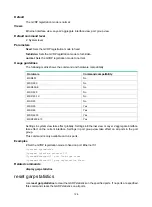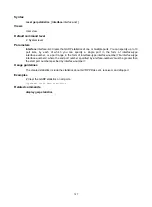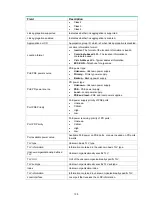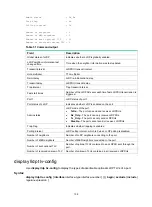
134
Field Description
•
Locally assigned
—Locally-defined chassis type other than
those listed above.
Chassis ID
ID that identifies the LLDP sending device, which can be a MAC
address, a network address, an interface or some other value
depending on the chassis type.
Port ID type
Port ID representation:
•
Interface alias
.
•
Port component
.
•
MAC address
.
•
Network address(ipv4)
.
•
Interface name
.
•
Agent circuit ID
.
•
Locally assigned
—Locally-defined port ID type other than
those listed above.
Port ID
Value of the port ID type.
System name
System name of the neighboring device.
System description
System description of the neighboring device.
System capabilities supported
Capabilities supported on the neighboring device:
•
Bridge
—Switching is supported.
•
Router
—Routing is supported.
System capabilities enabled
Capabilities enabled on the neighboring device:
•
Bridge
—Switching is enabled.
•
Router
—Routing is enabled.
Management address OID
Management address object ID.
Port and protocol VLAN ID(PPVID)
Port protocol VLAN ID.
Port and protocol VLAN supported
Indicates whether protocol VLAN is supported on the port.
Port and protocol VLAN enabled
Indicates whether protocol VLAN is enabled on the port.
VLAN name of VLAN 1
Name of VLAN 1.
Auto-negotiation supported
Indicates whether auto-negotiation is supported on the port.
Auto-negotiation enabled
Indicates whether auto-negotiation is enabled on the port.
OperMau
Speed and duplex state on the port.
Power port class
PoE device type:
•
PSE
—Power sourcing equipment.
•
PD
—Powered device.
PSE power supported
Indicates whether the device can operate as a PSE.
PSE power enabled
Indicates whether the device is operating as a PSE.
PSE pairs control ability
Indicates whether the PSE-PD pair control is available.
Power pairs
PoE mode:
•
Signal
—PoE via signal lines.
•
Spare
—PoE via spare lines.
Port power classification
Port power classification of the PD:
•
Class
0.
•
Class
1.
















































